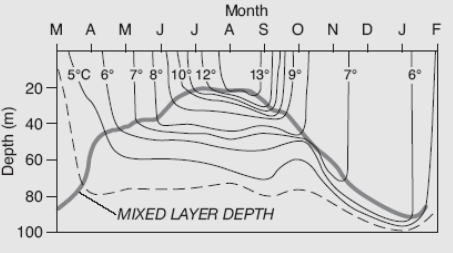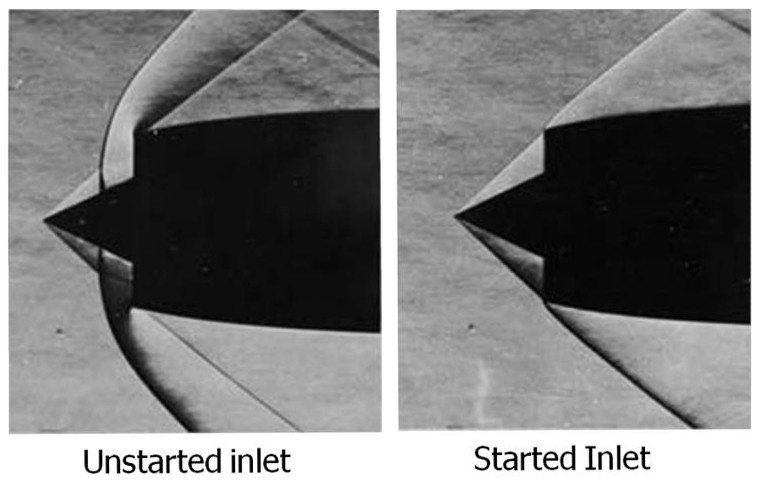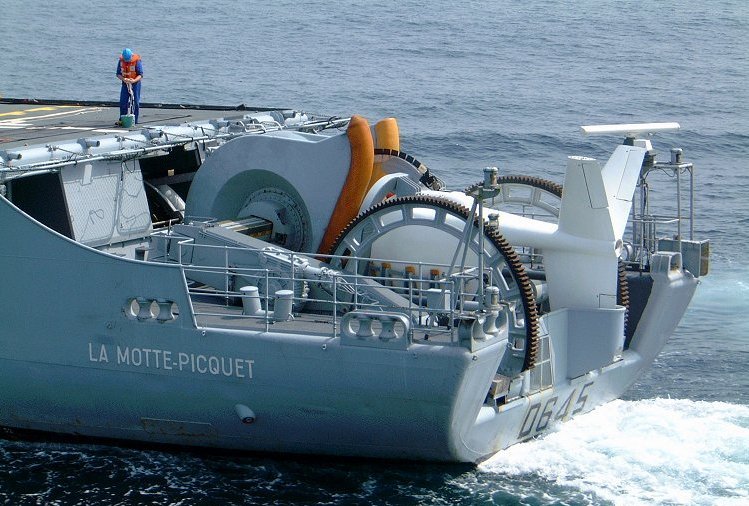|
Thermocline
A thermocline (also known as the thermal layer or the metalimnion in lakes) is a distinct layer based on temperature within a large body of fluid (e.g. water, as in an ocean or lake; or air, e.g. an atmosphere) with a high gradient of distinct temperature differences associated with depth. In the ocean, the thermocline divides the upper mixed layer from the calm deep water below. Depending largely on season, latitude, and turbulent mixing by wind, thermoclines may be a semi-permanent feature of the body of water in which they occur, or they may form temporarily in response to phenomena such as the radiative heating/cooling of surface water during the day/night. Factors that affect the depth and thickness of a thermocline include seasonal weather variations, latitude, and local environmental conditions, such as tides and currents. Oceans Most of the heat energy of the sunlight that strikes the Earth is absorbed in the first few centimeters at the ocean's surface, which hea ... [...More Info...] [...Related Items...] OR: [Wikipedia] [Google] [Baidu] |
Mixed Layer
The oceanic or limnological mixed layer is a layer in which active turbulence has homogenized some range of depths. The surface mixed layer is a layer where this turbulence is generated by winds, surface heat fluxes, or processes such as evaporation or sea ice formation which result in an increase in salinity. The atmospheric mixed layer is a zone having nearly constant potential temperature and specific humidity with height. The depth of the atmospheric mixed layer is known as the mixing height. Turbulence typically plays a role in the formation of fluid mixed layers. Oceanic mixed layer Importance of the mixed layer The mixed layer plays an important role in the physical climate. Because the specific heat of ocean water is much larger than that of air, the top 2.5 m of the ocean holds as much heat as the entire atmosphere above it. Thus the heat required to change a mixed layer of 2.5 m by 1 °C would be sufficient to raise the temperature of the atmosphere by 1&nbs ... [...More Info...] [...Related Items...] OR: [Wikipedia] [Google] [Baidu] |
Hypolimnion
The hypolimnion or under lake is the dense, bottom layer of water in a thermally- stratified lake. The word " hypolimnion" is derived from . It is the layer that lies below the thermocline. Typically the hypolimnion is the coldest layer of a lake in summer, and the warmest layer during winter. In deep, temperate lakes, the bottom-most waters of the hypolimnion are typically close to 4 °C throughout the year. The hypolimnion may be much warmer in lakes at warmer latitudes. Being at depth, it is isolated from surface wind-mixing during summer, and usually receives insufficient irradiance (light) for photosynthesis to occur. Oxygen dynamics The deepest portions of the hypolimnion often have lower oxygen concentrations than the surface waters (i.e., epilimnion). While oxygen can typically exchange between surface waters and the atmosphere (i.e., in the absence of ice cover), bottom waters are comparatively isolated from atmospheric replenishment of oxygen. In particular, d ... [...More Info...] [...Related Items...] OR: [Wikipedia] [Google] [Baidu] |
Epilimnion
The epilimnion or surface layer is the top-most layer in a thermally stratified lake. The epilimnion is the layer that is most affected by sunlight, its thermal energy heating the surface, thereby making it warmer and less dense. As a result, the epilimnion sits above the deeper metalimnion and hypolimnion, which are colder and denser. Additionally, the epilimnion is typically has a higher pH and higher dissolved oxygen concentration than the hypolimnion. Physical Structure Properties In the water column, the epilimnion sits above all other layers. The epilimnion is only present in stratified lakes. On the topside of the epilimnion it is in contact with air, which leaves it open to wind action, which allows the water to experience turbulence. Turbulence and convection work together to make waves which increases aeration. On the bottom side of the epilimnion is the metalimnion, which contains the thermocline. The thermocline is created because of the difference in te ... [...More Info...] [...Related Items...] OR: [Wikipedia] [Google] [Baidu] |
Mixed Layer
The oceanic or limnological mixed layer is a layer in which active turbulence has homogenized some range of depths. The surface mixed layer is a layer where this turbulence is generated by winds, surface heat fluxes, or processes such as evaporation or sea ice formation which result in an increase in salinity. The atmospheric mixed layer is a zone having nearly constant potential temperature and specific humidity with height. The depth of the atmospheric mixed layer is known as the mixing height. Turbulence typically plays a role in the formation of fluid mixed layers. Oceanic mixed layer Importance of the mixed layer The mixed layer plays an important role in the physical climate. Because the specific heat of ocean water is much larger than that of air, the top 2.5 m of the ocean holds as much heat as the entire atmosphere above it. Thus the heat required to change a mixed layer of 2.5 m by 1 °C would be sufficient to raise the temperature of the atmosphere by 1&nbs ... [...More Info...] [...Related Items...] OR: [Wikipedia] [Google] [Baidu] |
Lake Stratification
Lake stratification is the tendency of lakes to form separate and distinct thermal layers during warm weather. Typically stratified lakes show three distinct layers: the epilimnion, comprising the top warm layer; the thermocline (or metalimnion), the middle layer, whose depth may change throughout the day; and the colder hypolimnion, extending to the floor of the lake. Every lake has a set mixing regime that is influenced by lake morphometry and environmental conditions. However, changes to human influences in the form of land use change, increases in temperature, and changes to weather patterns have been shown to alter the timing and intensity of stratification in lakes around the globe. Rising air temperatures have the same effect on lake bodies as a physical shift in geographic location, with tropical zones being particularly sensitive. These changes can further alter the fish, zooplankton, and phytoplankton community composition, in addition to creating gradients that alter ... [...More Info...] [...Related Items...] OR: [Wikipedia] [Google] [Baidu] |
Mirage
A mirage is a naturally-occurring optical phenomenon in which light rays bend via refraction to produce a displaced image of distant objects or the sky. The word comes to English via the French ''(se) mirer'', from the Latin ''mirari'', meaning "to look at, to wonder at". Mirages can be categorized as "inferior" (meaning lower), "superior" (meaning higher) and " Fata Morgana", one kind of superior mirage consisting of a series of unusually elaborate, vertically stacked images, which form one rapidly-changing mirage. In contrast to a hallucination, a mirage is a real optical phenomenon that can be captured on camera, since light rays are actually refracted to form the false image at the observer's location. What the image appears to represent, however, is determined by the interpretive faculties of the human mind. For example, inferior images on land are very easily mistaken for the reflections from a small body of water. Inferior mirage In an inferior mirage, the mirage im ... [...More Info...] [...Related Items...] OR: [Wikipedia] [Google] [Baidu] |
Schlieren
Schlieren ( ; , ) are optical inhomogeneities in transparent media that are not necessarily visible to the human eye. Schlieren physics developed out of the need to produce high-quality lenses devoid of such inhomogeneities. These inhomogeneities are localized differences in optical path length that cause deviations of light rays, especially by refraction. This light deviation can produce localized brightening, darkening, or even color changes in an image, depending on the directions the rays deviate. History Schlieren were first observed by Robert HookeHooke, R. (1665), "Of a New Property in the Air", ''Micrographia'', Observation LVIII, pp. 217–219, London. in 1665 using a large concave lens and two candles. One candle served as a light source. The warm air rising from the second candle provided the schliere. The conventional schlieren system is credited mostly to German physicist August Toepler, though Jean Bernard Léon Foucault invented the method in 1859 that ... [...More Info...] [...Related Items...] OR: [Wikipedia] [Google] [Baidu] |
Refraction
In physics, refraction is the redirection of a wave as it passes from one transmission medium, medium to another. The redirection can be caused by the wave's change in speed or by a change in the medium. Refraction of light is the most commonly observed phenomenon, but other waves such as sound waves and Wind wave, water waves also experience refraction. How much a wave is refracted is determined by the change in wave speed and the initial direction of wave propagation relative to the direction of change in speed. Optical Prism (optics), prisms and Lens (optics), lenses use refraction to redirect light, as does the human eye. The refractive index of materials varies with the wavelength of light,R. Paschotta, article ochromatic dispersion in th, accessed on 2014-09-08 and thus the angle of the refraction also varies correspondingly. This is called dispersion (optics), dispersion and causes prism (optics), prisms and rainbows to divide white light into its constituent spectral ... [...More Info...] [...Related Items...] OR: [Wikipedia] [Google] [Baidu] |
Scuba Diving
Scuba diving is a Diving mode, mode of underwater diving whereby divers use Scuba set, breathing equipment that is completely independent of a surface breathing gas supply, and therefore has a limited but variable endurance. The word ''scuba'' is an Acronym#Normal case and acronyms, acronym for "Self-Contained Underwater Breathing Apparatus" and was coined by Christian J. Lambertsen in a patent submitted in 1952. Scuba divers carry their own source of breathing gas, affording them greater independence and movement than surface-supplied divers, and more time underwater than freedivers. Although the use of compressed air is common, other gas blends are also used. Open-circuit scuba systems discharge the breathing gas into the environment as it is exhaled and consist of one or more diving cylinders containing breathing gas at high pressure which is supplied to the diver at ambient pressure through a diving regulator. They may include additional cylinders for range extension, de ... [...More Info...] [...Related Items...] OR: [Wikipedia] [Google] [Baidu] |
Acoustic Impedance
Acoustic impedance and specific acoustic impedance are measures of the opposition that a system presents to the acoustic flow resulting from an acoustic pressure applied to the system. The International System of Units, SI unit of acoustic impedance is the pascal-second per cubic metre (symbol Pa·s/m3), or in the MKS system of units, MKS system the rayl per square metre (Rayl/m2), while that of specific acoustic impedance is the pascal-second per metre (Pa·s/m), or in the MKS system the rayl (Rayl). There is a Mechanical–electrical analogies#Impedance analogies, close analogy with electrical impedance, which measures the opposition that a system presents to the electric current resulting from a voltage applied to the system. Mathematical definitions Acoustic impedance For a LTI system theory, linear time-invariant system, the relationship between the acoustic pressure applied to the system and the resulting acoustic volume flow rate through a surface perpendicular to the di ... [...More Info...] [...Related Items...] OR: [Wikipedia] [Google] [Baidu] |
Sonar
Sonar (sound navigation and ranging or sonic navigation and ranging) is a technique that uses sound propagation (usually underwater, as in submarine navigation) to navigate, measure distances ( ranging), communicate with or detect objects on or under the surface of the water, such as other vessels. "Sonar" can refer to one of two types of technology: ''passive'' sonar means listening for the sound made by vessels; ''active'' sonar means emitting pulses of sounds and listening for echoes. Sonar may be used as a means of acoustic location and of measurement of the echo characteristics of "targets" in the water. Acoustic location in air was used before the introduction of radar. Sonar may also be used for robot navigation, and sodar (an upward-looking in-air sonar) is used for atmospheric investigations. The term ''sonar'' is also used for the equipment used to generate and receive the sound. The acoustic frequencies used in sonar systems vary from very low ( infrasonic) to e ... [...More Info...] [...Related Items...] OR: [Wikipedia] [Google] [Baidu] |







